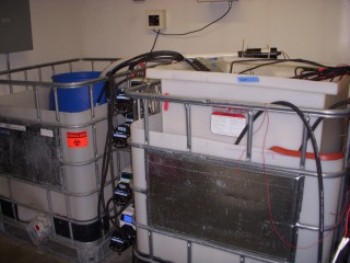At the American Chemical Society’s (ACS) 243rd National Meeting & Exposition, Orianna Bretschger from the J. Craig Venter Institute has demonstrated a new commercial version of the microbial fuel cell (MFC) that cleans municipal sewage and generates electricity at the same time.
 New microbial fuel cell cleans municipal sewage and generates electricity at the same time.
New microbial fuel cell cleans municipal sewage and generates electricity at the same time.
The innovative two-in-one device can process five times higher amount of sewage and can operate six times more efficiently than the earlier versions. In addition, the MFC requires half the cost of its predecessors.
Wastewater treatment technology that is available now includes several steps to separate the liquid and solid elements of sewage and to clean the polluted water before it is discharged into a water stream. The process involves the use of chemicals to kill harmful microbes, biological digestion steps, membranes to filter particles, macerators that split up larger objects and settling tanks. However, MFCs help to cut down the steps involved in wastewater treatment. MFCs use bacteria present in the municipal sewage to metabolize or digest organic materials. During the process, the microbes produce electrons, which are the fundamental units of electricity. With the use of the MFC, approximately 97% of the organic materials are removed. Though the water is clean, it is essential to achieve 99.99% to make the water potable.
Bretschger’s team has developed the first version of microbial fuel cell (MFC), which is referred as biological fuel cell, in 2011. They have increased the amount of waste that can be handled by the device from 20 to 100 gallons. In addition, the titanium components are replaced with graphite electrodes and a polyvinyl chloride (PVC) frame. These enhancements have decreased the cost of the new MFC. The researchers have also enhanced the energy recovery capacity of the MFC from approximately 2% to about 13%. Hence, if the technology is used commercially, a significant amount of energy can be generated and can have free wastewater treatment.